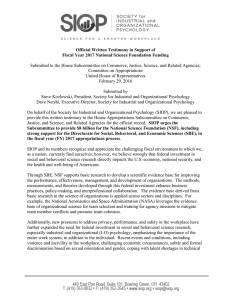SIOP Response to National Institute of General Medical Sciences
advertisement
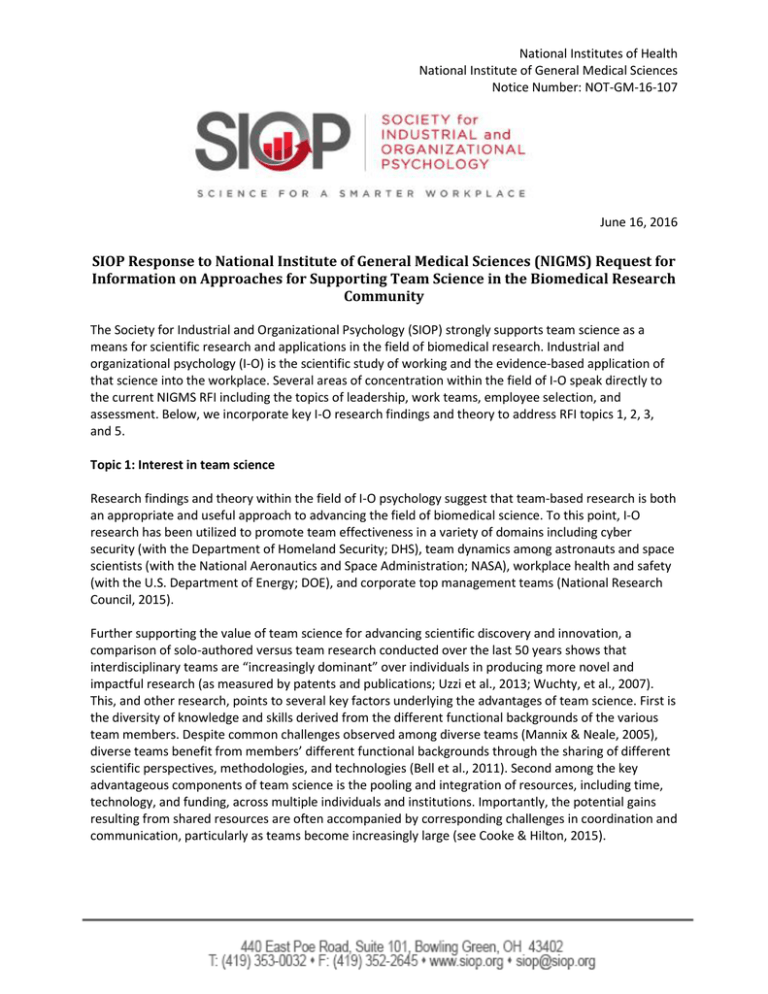
National Institutes of Health National Institute of General Medical Sciences Notice Number: NOT-GM-16-107 June 16, 2016 SIOP Response to National Institute of General Medical Sciences (NIGMS) Request for Information on Approaches for Supporting Team Science in the Biomedical Research Community The Society for Industrial and Organizational Psychology (SIOP) strongly supports team science as a means for scientific research and applications in the field of biomedical research. Industrial and organizational psychology (I-O) is the scientific study of working and the evidence-based application of that science into the workplace. Several areas of concentration within the field of I-O speak directly to the current NIGMS RFI including the topics of leadership, work teams, employee selection, and assessment. Below, we incorporate key I-O research findings and theory to address RFI topics 1, 2, 3, and 5. Topic 1: Interest in team science Research findings and theory within the field of I-O psychology suggest that team-based research is both an appropriate and useful approach to advancing the field of biomedical science. To this point, I-O research has been utilized to promote team effectiveness in a variety of domains including cyber security (with the Department of Homeland Security; DHS), team dynamics among astronauts and space scientists (with the National Aeronautics and Space Administration; NASA), workplace health and safety (with the U.S. Department of Energy; DOE), and corporate top management teams (National Research Council, 2015). Further supporting the value of team science for advancing scientific discovery and innovation, a comparison of solo-authored versus team research conducted over the last 50 years shows that interdisciplinary teams are “increasingly dominant” over individuals in producing more novel and impactful research (as measured by patents and publications; Uzzi et al., 2013; Wuchty, et al., 2007). This, and other research, points to several key factors underlying the advantages of team science. First is the diversity of knowledge and skills derived from the different functional backgrounds of the various team members. Despite common challenges observed among diverse teams (Mannix & Neale, 2005), diverse teams benefit from members’ different functional backgrounds through the sharing of different scientific perspectives, methodologies, and technologies (Bell et al., 2011). Second among the key advantageous components of team science is the pooling and integration of resources, including time, technology, and funding, across multiple individuals and institutions. Importantly, the potential gains resulting from shared resources are often accompanied by corresponding challenges in coordination and communication, particularly as teams become increasingly large (see Cooke & Hilton, 2015). National Institutes of Health National Institute of General Medical Sciences Notice Number: NOT-GM-16-107 Ongoing and future research on optimal team size, optimal amounts and types of team heterogeneity, and optimal team structures and processes will be important to maximizing the potential of team science for research in biomedicine and in other domains. However, given the supportive evidence for team science across a wide variety of contexts and purposes (Cooke & Hilton, 2015) and the inherently interdisciplinary nature of biomedicine, we believe team science to be a highly valuable means by which to advance the field. Topic 2: Management and advisory structures in team science Of key importance with regard to organizational structure and team science is the inherently multilevel structure of teams and their contexts, including that of individual team members and the many different institutions with which the team and its members interact. For example, institution-level support (e.g., training, resources) has been shown to influence team empowerment (Hempel et al., 2012). I-O psychologists have contributed extensively to multilevel research, theory, and analytic advancements and have demonstrated the importance of analyzing the role of organizational and team factors on individual team member behavior as well as the dynamic nature of individual and team performance over time (Bliese et al., 2007; Thoresen et al., 2004). Integral to the concept of team structure, leadership (both within the team itself and from supporting institutions) is another important factor in team effectiveness. More than 50 years of research within I-O and related fields has yielded substantial insight into how and why effective leaders influence individual and team behaviors and processes including communication, motivation, team cohesion, team climate, and conflict (Cooke & Hilton, 2015). Summarizing this research, a meta-analysis combining 131 study effects on the relationship between team leadership and team performance suggests that team leaders influence team effectiveness through shaping the way core tasks are performed within the team and through managing the socioemotional needs of the team members (Burke et al., 2006). Also of particular relevance to the often interdisciplinary nature of team science collaborations, leaders may play a critical role in building adaptive capabilities within the team (Kozlowski et al., 2009) and in creating shared understanding or “mental models” for the way capabilities and work are distributed within the team (Gray, 2008). Given the importance of organizational structure, team leadership, and institutional support for team effectiveness, SIOP recommends that team science project proposals carefully and clearly articulate plans for the team’s structure and processes at multiple levels within its system as well as the role of leadership in the team. National Institutes of Health National Institute of General Medical Sciences Notice Number: NOT-GM-16-107 Topic 3: Team composition A large subdomain of study within the field of I-O psychology is that of organizational staffing and employee selection. Much of the existing knowledge about employee selection is at the individual-level of analysis; at this level, the factors that tend to emerge as consistent predictors of individual work performance include cognitive ability (IQ) and conscientiousness (a personality trait related to motivation and persistence). However, team composition is more complicated than individual employee selection (Cooke & Hilton, 2015) and requires consideration of the interplay between individual team members’ knowledge, skills, abilities, and personality. Existing research and theory suggests several “best practices” with regard to team composition. First, and perhaps most importantly, team members should possess a high level of technical expertise in an area of relevance to the team’s purpose and goals (Cooke & Hilton, 2015). Second, teams should be constructed to maximally capitalize on a diversity of expertise from the different individual members of the team (Cummings et al., 2013). Third, regardless of their prior expertise and experience, team members should receive training and development aimed at enhancing knowledge sharing and team functioning (Cooke & Hilton, 2015). Fourth, decisions regarding team composition should incorporate consideration of theoretically and empirically relevant individual factors when selecting individual team members; these factors include general cognitive ability, a disposition to forge relationships and share information with others, and personality traits of conscientiousness and openness to experience (see Cooke & Hilton, 2015). Importantly, many other individual-level qualities may be important in achieving the ideal mix of capabilities and perspectives at the team-level. Although more research is needed on this subject, a study of 41 corporate research and development teams found that innovation was enhanced by including a balance of both creative and conformist team members (Miron-spektor et al., 2011). In sum, SIOP recommends that team science project proposals explicitly address how teams will be composed (and why), including consideration of the optimal team size, the optimal mix of team member expertise, and the optimal balance of team member personality. Additionally, SIOP recommends continued research on team science as a field of study itself in order to further understanding of how best to compose teams. Topic 5: Assessment of team science Assessment of team science projects is important not only from the perspective of reviewing and learning from a completed project’s successes and failures, but also from the perspective of planning National Institutes of Health National Institute of General Medical Sciences Notice Number: NOT-GM-16-107 projects in advance (Villado & Arthur, 2013). Thus, projects should be more likely to be successful when plans for post-project assessment are incorporated into the project proposal. Drawing from a large body of I-O psychology research on the assessment of individual, team, and organizational performance, SIOP recommends that funding agencies require authors of team-sciencebased proposals to specify collaboration plans and to explicate the process by which the different capabilities and perspectives of the team members (and their respective disciplines) will be integrated in the research process (Cooke & Hilton, 2015). Additionally, SIOP recommends that such proposals be required to explicate the intended project outcomes as specific indicators of the team’s effectiveness (e.g., publications, patents, specific impact on stakeholder well-being). References Bell, S. T., Villado, A. J., Lukasik, M. A., Belau, L., & Briggs, A. L. (2010). Getting specific about demographic diversity variable and team performance relationships: A meta-analysis. Journal of Management, 37, 709-743. Bliese, P.D., Chan, D., & Ployhart, R.E. (2007). Multilevel methods: Future directions in measurement, longitudinal analyses, and non-normal outcomes. Organizational Research Methods, 10, 551-563. Burke, C.S., Stagl, K.C., Klein, C., Goodwin, G.F., Salas, E., & Halpin, S.M. (2006). What type of leadership behaviors are functional in teams? A meta-analysis. Leadership Quarterly, 17, 288-307. Cook, N.J., & Hilton, M.L. (Eds.,). 2015. Enhancing the effectiveness of team science. Committee on the Science of Team Science; Board on Behavioral, Cognitive, and Sensory Sciences; Division of Behavioral and Social Sciences and Education; National Research Council. Washington, DC: The National Academies Press. Cummings, J.N., Kiesler, S., Zadeh,R., & Balakrishnan, A. (2013). Group heterogeneity increases the risks of large group size: A longitutdinal study of productivity in research groups. Psychological Science, 24, 880-890. Gray, B. (2008). Enhancing transdisciplinary research through collaborative leadership. American Journal of Preventative Medicine, 35(2S): S124-S132. Hempel, P.S., Zhang, Z., & Han, Y. (2012). Team empowerment and the organizational context: Decentralization and the contrasting effects of formalization. Journal of Management, 38, 475-501. National Institutes of Health National Institute of General Medical Sciences Notice Number: NOT-GM-16-107 Kozlowski, S.W.J., Watola, D.J., Jensen, J.M., Kim, B.H., & Botero, I.C. (2009). Developing adaptive teams: A theory of dynamic team leadership. In E. Salas, G.F. Goodwin, and C.S. Burke (Eds.), Team effectiveness in complex organizations: Cross-disciplinary perspectives and approaches (pp. 113-155). New York: Routledge. Mannix, E., & Neale, M.A. (2005). What differences make a difference? The promise and reality of diverse teams in organizations. Psychological Science in the Public Interest, 6, 31-55. Miron-spektor, E., Erez, M., & Naveh, E. (2011). The effect of conformist and attentive-to-detail members on team innovation: Reconciling the innovation paradox. Academy of Management Journal, 54, 740-760. National Research Council (2015). Enhancing the Effectiveness of Team Science. Committee on the Science of Team Science, N.J. Cooke and M.L. Hilton, Editors. Washington, DC: The National Academies Press. Stvilia, B., Hinnant, C. C., Schindler, K., Worrall, A., Burnett, G., Burnett, K., … & Marty, P. F. (2011). Composition of scientific teams and publication productivity at a national science lab. Journal of the American Society for Information Science and Technology, 62(2), 270-283. Thoresen, C.J., Bradley, J.C., Bliese, P.D., & Thoresen, J.D. (2004). The big five personality traits and individual job performance growth trajectories in maintenance and transitional job stages. Journal of Applied Psychology, 89, 835-853. Uzzi, B., Mukherjee, S., Stringer, M., & Jones, B. (2013). Atypical combinations and scientific impact. Science, 342(6157), 468-472. Villado, A. J., & Arthur Jr, W. (2013). The comparative effect of subjective and objective after-action reviews on team performance on a complex task. Journal of Applied Psychology, 98(3), 514. Wuchty, S., Jones, B. F., & Uzzi, B. (2007). The increasing dominance of teams in production of knowledge. Science, 316(5827), 1036-1039.
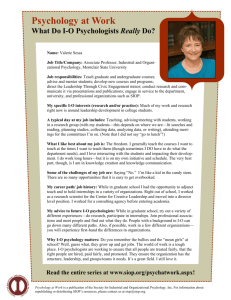
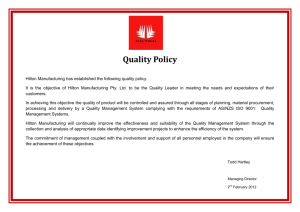
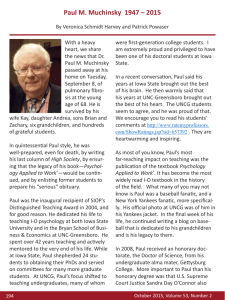
![-----Original Message----- From: Michael W. Cooke [ ]](http://s2.studylib.net/store/data/015586944_1-4fd695658a0505b410d5514bb22e4537-300x300.png)
